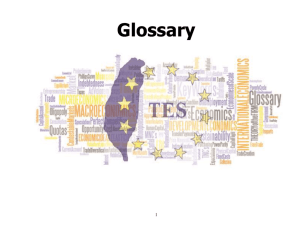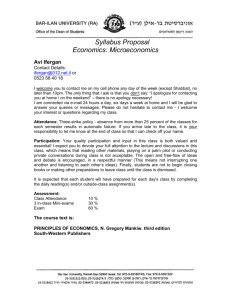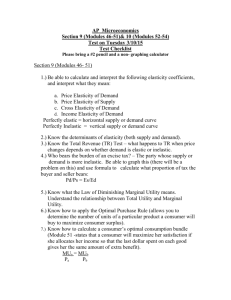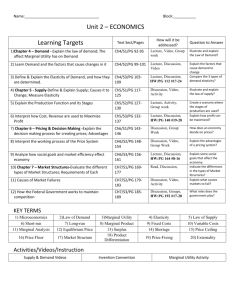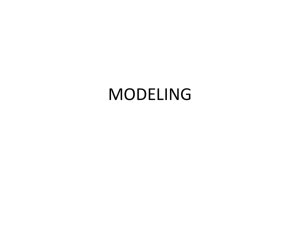Economics - Bieap.gov.in
advertisement
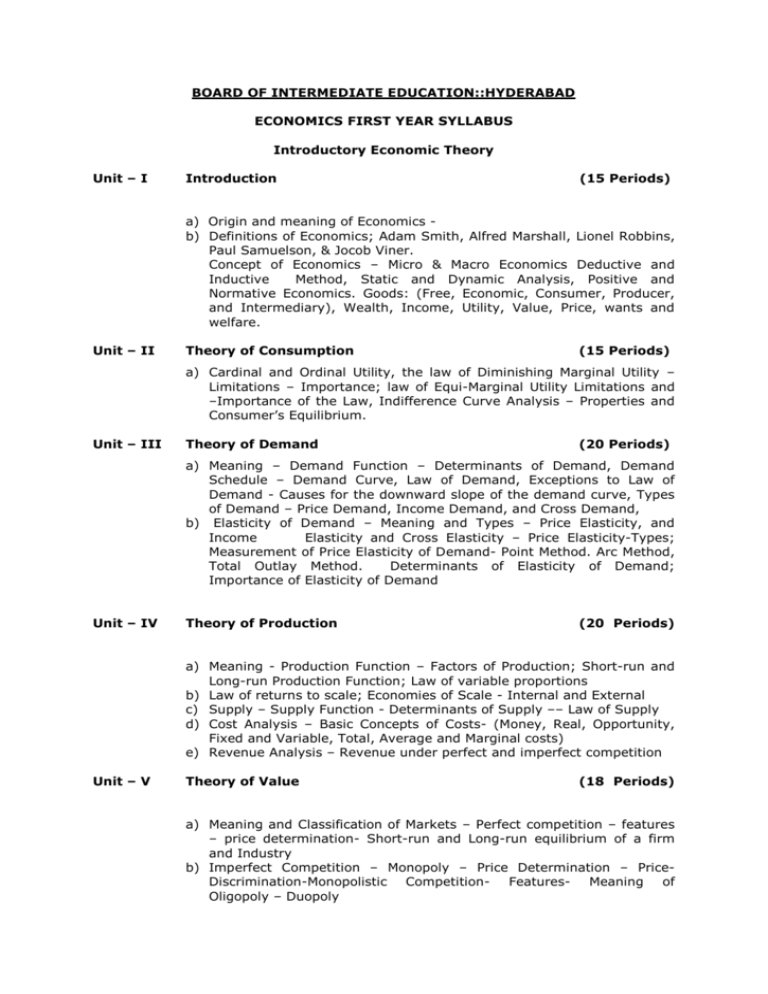
BOARD OF INTERMEDIATE EDUCATION::HYDERABAD ECONOMICS FIRST YEAR SYLLABUS Introductory Economic Theory Unit – I Introduction (15 Periods) a) Origin and meaning of Economics b) Definitions of Economics; Adam Smith, Alfred Marshall, Lionel Robbins, Paul Samuelson, & Jocob Viner. Concept of Economics – Micro & Macro Economics Deductive and Inductive Method, Static and Dynamic Analysis, Positive and Normative Economics. Goods: (Free, Economic, Consumer, Producer, and Intermediary), Wealth, Income, Utility, Value, Price, wants and welfare. Unit – II Theory of Consumption (15 Periods) a) Cardinal and Ordinal Utility, the law of Diminishing Marginal Utility – Limitations – Importance; law of Equi-Marginal Utility Limitations and –Importance of the Law, Indifference Curve Analysis – Properties and Consumer’s Equilibrium. Unit – III Theory of Demand (20 Periods) a) Meaning – Demand Function – Determinants of Demand, Demand Schedule – Demand Curve, Law of Demand, Exceptions to Law of Demand - Causes for the downward slope of the demand curve, Types of Demand – Price Demand, Income Demand, and Cross Demand, b) Elasticity of Demand – Meaning and Types – Price Elasticity, and Income Elasticity and Cross Elasticity – Price Elasticity-Types; Measurement of Price Elasticity of Demand- Point Method. Arc Method, Total Outlay Method. Determinants of Elasticity of Demand; Importance of Elasticity of Demand Unit – IV Theory of Production (20 Periods) a) Meaning - Production Function – Factors of Production; Short-run and Long-run Production Function; Law of variable proportions b) Law of returns to scale; Economies of Scale - Internal and External c) Supply – Supply Function - Determinants of Supply –– Law of Supply d) Cost Analysis – Basic Concepts of Costs- (Money, Real, Opportunity, Fixed and Variable, Total, Average and Marginal costs) e) Revenue Analysis – Revenue under perfect and imperfect competition Unit – V Theory of Value (18 Periods) a) Meaning and Classification of Markets – Perfect competition – features – price determination- Short-run and Long-run equilibrium of a firm and Industry b) Imperfect Competition – Monopoly – Price Determination – PriceDiscrimination-Monopolistic Competition- Features- Meaning of Oligopoly – Duopoly Unit – VI Theory of Distribution (12 Periods) a) Determination of Factor Prices – Marginal Productivity Theory b) Rent – Ricardian theory of Rent – Modern theory - Quasi Rent – Transfer earnings. c) Wages – Meaning and types of wages – Money and Real wages d) Interest- Meaning – Gross and Net interests e) Profits – Meaning – Gross and Net profits Unit – VII National Income (15 Periods) a) Definitions of National Income and Concepts b) Measurement of National Income – Census of Product Method – Census of Income Method – Census of Expenditure Method c) Methods of Measuring National Income in India; Problems and importance Unit – VIII Macro Economic Aspects (20 Periods) a) Classical theory of Employment –J.B. Say Law of Markets- Limitations – J.M. Keynes Effective Demand. b) Public Economics - Public Revenue – Public Expenditure – Public debt – Components of Budget. Unit – IX Money, Banking and Inflation (15 Periods) a) Money – Definitions and Functions of money – Types of Money b) Banking – Commercial Banks – Functions; Central Bank – Functions – Reserve Bank of India – Net Banking. c) Inflation – Definitions – Types – Causes and Effects of inflation – Remedial Measures Unit – X Periods) Statistics for Economics (15 a) Meaning, Scope and Importance of Statistics in Economics with Diagrams (Bar diagrams and Pie diagrams) Measures of central tendency – Mean, Median, Mode. BOARD OF INTERMEDIATE EDUCATION, A.P, HYDERABAD MODEL QUESTION PAPER- ECONOMICS- I YEAR (W.E.F.2014-15) Time: 3 Hours Max.marks:100 Section – A Answer any Three out of the following Five questions 3x10 =30marks 1. Explain the law of Diminishing Marginal Utility with the help of diagram. What are its limitations? 2. Explain Law of Variable Proportions with help of a diagram. 3. Define Perfect Competition. How Price of a commodity is determined under Perfect Competition? 4. Explain various methods of measuring National Income. 5. What is Price Elasticity of Demand? Explain the different forms of Price Elasticity of Demand. Section – B Answer any eight out of the following twelve questions 6. Explain the circular flow of income with suitable diagram. 7. Why a Demand Curve has a negative slope? 8. What are the exceptions to the law of Demand? 9. What are the properties of indifference curves? 10. Explain the meaning of ‘U’ shaped MC curve? 11. What are the main features of Monopoly? 12. What are the factors that determine Real Wages? 13. Explain Effective demand? 14. Calculate the Mean from the following data Marks : 0-10, 10-20, 20-30, 30-40, 40-50, 50-60, 60-70. No. of Students: 5, 12, 15, 25, 8, 3, 2. 15. Write any five methods of redemption of Public Debt. 16. Enumerate the measures for control of Inflation. 17. State the contingent functions of Money. 8x5=40marks Section – C Answer any fifteen out of the following twenty questions 18. What is meant by Capital Goods? 19. Define Micro Economics? 20. Cardinal Utility. 21. What is Cross Demand? 22. Write Demand Function? 23. Calculate Arithmetic Mean from the data 40, 50, 55, 60, 65, 70, 75. 24. Write about Arc Method. 25. Calculate Median from the data. 6, 8, 2, 12, 13, 5, 15. 26. Draw an Indifference Map. 27. What is meant by Consumer Equilibrium? 28. Average Revenue. 29. Fixed Costs. 30. Monopolistic Competition. 31. What is Price Discrimination? 32. Quasi Rent. 33. Find out the Mode from this data. 3, 2, 5, 7, 2, 8, 2, 9. 34. What is Per Capita Income? 35. Disposable Income. 36. Define Say’s Law of Market. 37. Demand-Pull Inflation. ******* 15x2 =30marks

